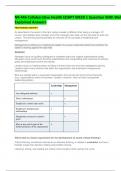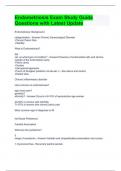NR 446 Collaborative Health EDAPT WEEK 1 Question With Well Explained Answers PROFFESIONAL IDENTITY: As described in the quote to the right, being a leader is different than being a manager. Of course, most leaders also manage, and most managers also lead, yet the skill sets for each are unique. This learning activity provides an overview of the concepts of leadership and management. Management is efficiency in climbing the ladder of success; leadership determines whether the ladder is leaning against the right wall. Question: Managers focus on guiding colleagues to complete tasks that support organizational goals. Managers have control over directing subordinates and manipulating their resources to achieve goals and emphasize control and results. Leaders focus on inspiring others to follow a shared vision but have less delegated authority. Leaders hold a more informal role within the organization and emphasize interpersonal relationships. Both are needed within a successful organization and can be part of the formal hierarchy (e.g., organizational chart) of business. Leaders, however, may not hold a recognized leadership position. Leadership Management Less delegated authority x Direct subordinates x Emphasizes control and results x Emphasizes interpersonal relationships x Manipulate resources to achieve goals x May or may not be part of the formal hierarchy of the organization x Which skill is a basic requirement for the development of sound critical thinking? Critical thinking, sometimes referred to as reflective thinking, is related to evaluation and has a broader scope than decision making and problem solving. Listening, writing, and reading are critical communication skills used by the nurse. Which process is not used to support decision making by the nurse and nurse leader? Assuming can prevent the nurse from questioning the facts of a situation, which leads to poor decisions. Critical thinking, a cognitive process, and problem solving, a systematic process, both support decision making by focusing on the thoughts of the person deciding. Deductive reasoning allows for inferences to be drawn from information during the problem - solving process. Empathy, along with insight and intuition, are components of critical thinking. DEFINDING LEADERSHIP AND MANAGEMENT: If a manager guides, directs, motivates, and empowers others, then it could be said that every manager should be a leader. Similarly, leadership without management results in chaos and failure for both the organization and the individual executive. Current leadership theory views leaders as those who guide workers to embrace and work towards the goals of an organization by setting an example . Managers , on the other hand, are those who supervise processes and direct workers to meet the goals of the organization. Yet the reality is that any nurse who has direct reports must be able to both supervise people and processes and be an example that guides others to support the organization. Management: • Supervises processes • Directs workers Leadership: • Sets examples • Guides workers WHY HAVE LEADERS AND MANAGERS? Roles of Managers: • Are assigned a position by the organization • Have a legitimate source of power due to delegated authority that accompanies their position • Have specific duties and responsibilities they are expected to carry out • Emphasize control, decision making, decision analysis, and results • Manipulate people, the environment, money, time, and other resources to achieve the goals of the organization • Have a greater formal responsibility and accountability for rationality and control than leaders • Direct willing and unwilling subordinates Roles of Leaders: • Often do not have delegated authority but obtain power through other means, such as influence • Have a wider variety of roles than managers • Focus on group process, information gathering, feedback, and empowering others • May or may not be part of the formal hierarchy of the organization • Emphasize interpersonal relationships • Direct willing followers • Have goals that may or may not reflect those of the organization Types of leaders: In many successful organizations, leaders can be found in designated leadership positions or working in subordinate positions. No matter their position in the organization, leaders inspire trust and motivate others to actively support their vision. Select each type of leader to learn more. Formal leaders hold positions of authority within the organization and are expected to influence, empower, and manage others (Ross, 2014). Examples of formal leaders include the Chief Academic Officer of a college of nursing, a unit nurse manager, and a shift nursing supervisor. Informal leaders are those who have influence over their peers, despite not being in an organizationally recognized position of authority (Lawson et al., 2018). Examples of informal leaders include a staff nurse whose peers seek their input on returning to school, or a licensed practical nurse who encourages a colleague to join a unit’s shared governance committee. A nurse is appointed to a charge nurse position in a local hospital. Which term best describes this new role? Formal leaders hold positions of authority within the organization in which they are expected to influence, empower, and manage others (Ross, 2014). This is usually accomplished by appointment (or assigned) by those holding higher positions within the organization. Informal leaders are those who have influence over their peers, despite not being in an organizationally recognized position of authority (Lawson et al., 2018). Manager and colleague are terms that describe positions within an organization. KEY COGNITIVE SKILLS FOR LEADERS: Three related skills required by a successful nurse are the ability to make decisions, solve problems, and think critically (Marquis & Huston, 2020; Social Science, 2020). Often used interchangeably, these skills are closely related yet unique. Together, critical thinking, problem - solving, and decision -making form the basis for clinical reasoning. Select each tab for details on these key skills. Critical thinking - Used for both decis ion-making and problem -solving, critical thinking is the way a person takes control of thinking using an intellectual process. This structured thinking raises vital questions used to gather relevant information with an open mind (The Foundation for Critical Thinking, n.d.). The person who thinks critically uses the information gathered alone, or with others, to reach solutions to complex problems. The advantage of using critical thinking in nursing, whether as a staff nurse or nurse leader, is that it helps the nurse understand the current situation or need, consider what it means to the client or staff, examine the available evidence and current reasoning, and reach a judgement. Problem – Solving - Seeking to eliminate a problem or issue, problem -solving is a systematic process used to complete a full analysis of all known data. The goal is to discover the root cause of an issue and ends when a decision is made on how to proceed. Critical thinking supports problem -solving when nurses ask questions and keep open minds to gather all relevant data. Decision -making is a cognitive process influenced by a person’s value system, used to select a course of action to eliminate a problem. Although decision -making is the final step in the proble m-solving process, it is possible to make decisions without understanding the root cause, including during an emergency situation for which a protocol is used. For example, when the nurse finds an unresponsive client, cardiopulmonary resuscitation (CPR) is started with an assessment of the airway. In this instance, following a CPR algorithm (list of all tasks to follow) replaces decision -making in order to save a life. By following an algorithm, decision -making by the individual nurse has been removed. Evid ence -based research has already determined the best course of action. This is crucially important when life -saving measures are needed. Critical thinking is used in decision -making to determine the root cause of an issue when an immediate decision is not required, or a protocol is in place. CRITICAL ELEMENTS IN DECISION MAKING: The nurse leader uses the same process for decision -making as the staff nurse, but with a different focus. Where the staff nurse’s decisions concern client care, the nurse manager attends to the details that allow a nursing unit to run smoothly. For both nurse leaders and staff nurses, the use of a structured decision -making process ultimately guides the nurse’s attention to the process, organizes thoughts, and helps offset human error through the structured critical thinking process. Go through the interactive to the right for more information on what structured decision making requires of a leader. Define Objectives Clearly • If a decision lacks a clear objective or if an objective is not consistent with the individual’s or organization’s stated philosophy, a poor-quality decision is likely to be made. Gather Data Carefully • Sources of data available for a nurse leader include clients, staff, reports on unit activity, and information shared by their peers. • Facts can be misleading if they are presented in a suggestive manner, taken out of context, or are past -oriented. • Pre-conceived ideas or personal values could alter how data is interpreted, which may lead to bias in decision making.





